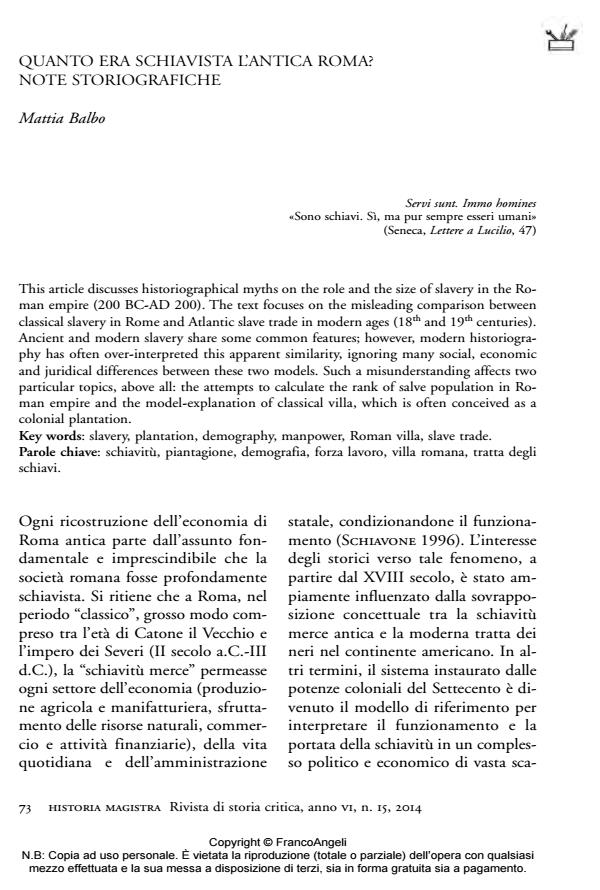Quanto era schiavista l’antica Roma? Note storiografiche
Titolo Rivista HISTORIA MAGISTRA
Autori/Curatori Mattia Balbo
Anno di pubblicazione 2015 Fascicolo 2014/15 Lingua Italiano
Numero pagine 5 P. 73-77 Dimensione file 78 KB
DOI 10.3280/HM2014-015007
Il DOI è il codice a barre della proprietà intellettuale: per saperne di più
clicca qui
Qui sotto puoi vedere in anteprima la prima pagina di questo articolo.
Se questo articolo ti interessa, lo puoi acquistare (e scaricare in formato pdf) seguendo le facili indicazioni per acquistare il download credit. Acquista Download Credits per scaricare questo Articolo in formato PDF

FrancoAngeli è membro della Publishers International Linking Association, Inc (PILA)associazione indipendente e non profit per facilitare (attraverso i servizi tecnologici implementati da CrossRef.org) l’accesso degli studiosi ai contenuti digitali nelle pubblicazioni professionali e scientifiche
This article discusses historiographical myths on the role and the size of slavery in the Roman empire (200 BC-AD 200). The text focuses on the misleading comparison between classical slavery in Rome and Atlantic slave trade in modern ages (18th and 19th centuries). Ancient and modern slavery share some common features; however, modern historiography has often over-interpreted this apparent similarity, ignoring many social, economic and juridical differences between these two models. Such a misunderstanding affects two particular topics, above all: the attempts to calculate the rank of salve population in Roman empire and the model-explanation of classical villa, which is often conceived as a colonial plantation.;
Keywords:Schiavitù, piantagione, demografia, forza lavoro, villa romana, tratta degli schiavi.
- Beloch K.J., La popolazione del mondo greco-romano in Pareto V. (a cura di) Biblioteca di storia economica, IV, Forni, Milano 1909, pp. 65-459 (ed. or. Die Bevölkerung der griechisch-römischen Welt, Duncker & Humblot, Leipzig 1886).
- Brunt P.A., Italian Manpower 225 B.C.- A.D. 14, Clarendon, Oxford 1971. Capogrossi Colognesi L., Proprietari e contadini nell’Italia romana: la preistoria della villa schiavistica (IVII secolo a.C.), in Le travail. Recherches historiques. Table ronde de Besançon, 14 et 15 novembre 1997, Presses Universitaires Franc-Comtoises, Besançon-Paris 1999, pp. 87-100.
- Carandini A., Settefinestre.Una villa schiavistica nell’Etruria romana, Panini, Modena 1985.
- Finley M.I., Ancient slavery and modern ideology, Chatto & Windus, London 1980. Gibbon E., The history of the decline and fall of the Roman Empire, Strahan & Cadell, London 1776-1788.
- Hopkins K., Conquistatori e schiavi. Sociologia dell’Impero romano, Boringhieri, Torino 1984 (ed. or. Conquerors and Slaves, CUP, Cambridge, 1984 1978).
- Launaro A., Peasants and slaves. The rural population of Roman Italy (200 BC to AD 100), CUP, Cambridge 2011.
- Lo Cascio E., Crescita e declino. Studi di storia dell’economia romana, «L’Erma » di Bretschneider, Roma 2009.
- Lo Cascio E., Thinking slave and free in coordinates, in Roth U. (a cura di) By the Sweat of your Brow. Roman slavery in its socio-economic setting, Institute of Classical Studies, London 2010, pp. 21-30.
- Marzano A., Roman villas in Central Italy. A social and economic history, Brill, Leiden-Boston 2007.
- Scheidel W., Human mobility in Roman Italy. II. The slave population, in «The Journal of Roman Studies», n.
- 95, 2005, pp. 64-79.
- Schiavone A., La storia spezzata. Roma antica e Occidente moderno, Laterza, Roma-Bari 1996.
Mattia Balbo, Quanto era schiavista l’antica Roma? Note storiografiche in "HISTORIA MAGISTRA" 15/2014, pp 73-77, DOI: 10.3280/HM2014-015007